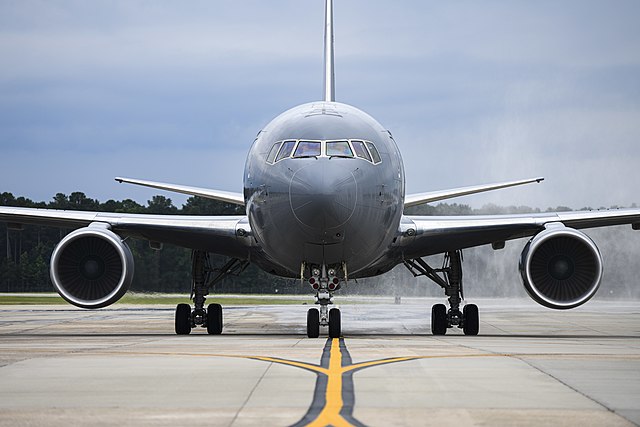Israel Will Buy The KC-46A Tanker (And Maybe More F-35s Too)
By SETH J. FRANTZMAN
By Jacob Derry – https://www.dvidshub.net/image/6240188/first-kc-46a-pegasus-lands-seymour-johnson, Public Domain, https://commons.wikimedia.org/w/index.php?curid=95266037
Israel’s multi-billion dollar acquisition deal for a fleet of new U.S. aircraft crossed another hurdle in mid-February as a ministerial procurement committee accepted a demand by the Defense Ministry to buy four Boeing KC-46A aircraft and possibly a variety of other aircraft and helicopters. For more than a decade Israel has been looking at new helicopters and has considered whether it needs more F-35 stealth fighters. The country still hasn’t received all of the fifty F-35s it already acquired, but given the long pipeline for procurement, planning ahead is important.
The KC-46A Pegasus is a widebody multirole refueler and is key to Israel’s strategy. On February 15 Israel launched a surprise massive air force drill designed to simulate a possible war with Hezbollah and other Iranian threats. The reports that Israel is moving forward with interest in more F-35s, possibly V-22 helicopters and possibly Boeing Chinooks or Sikorsky CH-53K helicopters, date back to 2020. On February 7 the massive purchased received initial support from the country’s security cabinet. Like all procurement programs this is a long process. Israeli Defense Minister Benny Gantz, who has been in his position for almost a year, has pushed to move forward with these deals. However, he will likely leave office with new elections in March, meaning this is an achievement that he needs to get to the end zone. He’s still running the ball at the moment.
The problem for Israel is that despite the fact it is at the cutting edge of military technology, like its Iron Dome air defense, and makes some of the best sensors and electro-optics and other defense systems in the world, it still needs big air force platforms. Only the United States, a key ally for Israel, can provide these, because Israel doesn’t make airplanes or helicopters. Warplanes like the F-35 are not just a plane, but a system of systems, sponging up data using unique sensors and forming part of the future battlefield which is more networked and connected. Israel’s multi-year Momentum plan envisions knitting together all this technology. But military’s need refuelers and large transport helicopters to do that. Israel’s aging fleet of Boeing 707s need a boost from new refuelers and Israel recently modernized its Hercules C-130 HI fleet.
Regarding the C-130 HI “Karnaf” squadron Israel says that it recently took delivery of the eighth and final upgrade for these aircraft. The cockpit underwent an upgrade and the planes have a new head-up display like one would have on a fighter aircraft. Israel’s Elbit Systems led the modernization program.
For new planes Israel will seek initially include four KC-46A aircraft, part of a possible eight that could be bought for $2.4 billion. The procurement committee accepted the demands on February 16. Gantz also reportedly wants the V-22. It’s possible that new F-15EX purchases could be on the horizon as well. However, the decision on F-15s and more helicopters has been put off to a later date. For now, the acquisitions committee supports a new squadron of F-35s and the four Boeing KC-46s. Loans from the U.S. will pay for the aircraft.
How Israel will pay for the program is not entirely clear. The Finance Ministry in Israel is opposed. Israel hopes to dip into the $3.8 billion it receives annually as part of a decade-long Memorandum of Understanding with the United States. Loans from banks will cover the deal, Times of Israel reported. Defense Ministry Director General Amir Eshel, formerly head of the Israel Air Force, discussed the budget strategy in mid-February. Washington wants Israel to have a priority, but it always wants Israel to make a decision on these deals.
A report by the Jewish Institute for National Security of America put out on February 16 looked at how “frontloading” of the financing could accelerate Israeli procurement of vital weaponry. According to the JINSA report recommendations the U.S. Congress should authorize Israel to use funds “set forth in the MoU to cover the interest of this loan.” A new MoU with Israel will have to be discussed in 2028.
The Foreign Military Financing Israel receives, as well as funding for joint air defense programs such as Arrow and David’s Sling, has helped Israel to have a qualitative military edge in the Middle East and become a key partner of the U.S. defense industry. Many companies in Israel, such as defense giant Rafael Advanced Defense Systems, partner with U.S. companies such as Raytheon. IAI in Israel makes wings for the F-35 and Elbit Systems makes helmets. Israel’s defense industry is closely connected to its U.S. counterparts, in a way that makes the country unique. However, the U.S. also wants to make sure the financing isn’t spent elsewhere, so the recent agreement foresees Israel spending one hundred percent of the support on U.S. defense products. Meaning, essentially, America is spending these billions on its own defense industry and Israel received the products. The by-product is that Israeli defense companies increasingly work and develop products with their U.S. counterparts and Israeli systems like Trophy defense system to help defend U.S. tanks.
JINSA’s report notes that Israel moved forward with its purchase plan on February 7 after three years of consideration. Israel is able to fund these purchases by “refinancing a loan it took out in 2014 to procure its second F-35 squadron.” That squadron was activated in early 2020. Israel conducted three defense drills, called Enduring Lightning, with U.S. F-35s in 2020. Now that Israel is moving to be under U.S. Central Command’s area of operations, it is expected to do more of these drills. JINSA says that this procurement is “long-overdue” for Israel. The report indicates that some approvals may be needed from the new Biden administration and support from the Pentagon. Congress is already on board.
The systems are important, but Israel’s current security concerns relate to Iran’s entrenchment in Syria and Iran’s role in Iraq, where Iran may be moving ballistic missiles. A recent IDF assessment assumes that Hezbollah will not want a large war this year with Israel, but may seek to stir up tensions. All these tensions risk escalation with Iran. Iran is also fanning flames of conflict in Yemen with support for the Houthis, and likely is behind a recent rocket attack on U.S. forces in Erbil. Hezbollah also tried to down an Israeli Hermes drone using a surface-to-air-missile in early February. The large context is that regardless of the new procurement plan, the planes may not arrive by the time Israel needs to make tough choices in the region.
Originally published in The National Interest

